#knox the apostle
Explore tagged Tumblr posts
Text
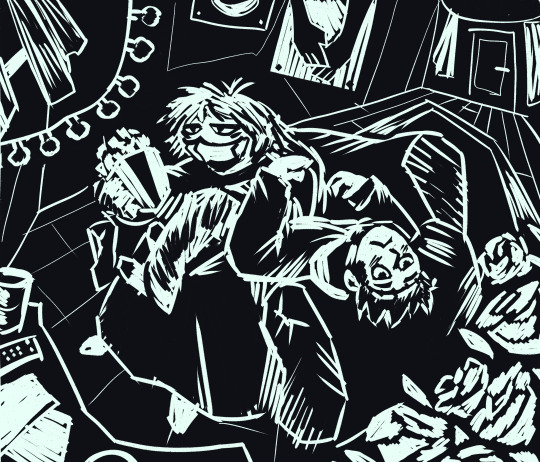
movie night
#impzart#oc art#original character#artists on tumblr#b&w#cason#knox the apostle#really happy i was able to do a full scene in this style
13 notes
·
View notes
Text
Our Morning Offering – 29 June – Decora Luce Aeternitatis, What Fairer Light
Our Morning Offering – 29 June – Saints Peter and Paul, Apostles Decora Luce AeternitatisWhat Fairer LightAttrib. to H Elphis (Died 493) Wife of Boethius c 477– 524)Trans. Msgr Ronald Knox (1888–1957) What fairer light is thisthan time itself doth own,The golden day with beamsmore radiant brightening?The Princes of God’s Churchthis Feast day doth enthrone,To sinners heavenward boundtheir burden…

View On WordPress
6 notes
·
View notes
Text
“…Hello?”

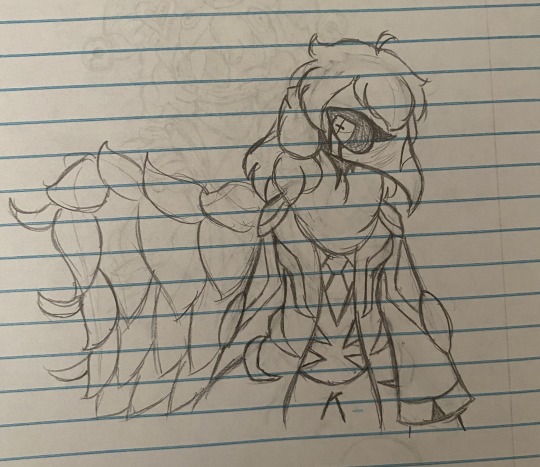
“ITS ON!”
“Good. I am Griffin, and I work in Disiplinary. That’s it.”
“What about the former Apostle 6 thing-“
“That is Knox, and they work in Control.”
“Heyyyy you-“
“That is all.”
(Heyyyy I made another rp acc for my other nuggets Griffin and Knox! My other rp blog is @safety-welfare-record! EDIT: Wetherby got her own blog with her brother! @info-sibling-duo)
5 notes
·
View notes
Text
More NUGGETS!



Hey guys have more nuggets! And these two! um. Where do I begin.
First we have Griffin! Formerly the 6th Apostle, she(and everyone else)…don’t know how she turned back into an employee with (minimal) consequences apart from the mask (which she can remove), and neck fluff (physically attached. Yes it fluffs up when she’s mad). She’s the main WhiteNight handler and works mainly in Disiplinary. Her main weapon is Adoration! And then we have Knox! Oh boy! So Knox kinda used to be a Crimson Ordeal (Cheers for the Beginning so technically he’s an abnormality. it’s complicated) until he got. very intrigued by L-Corp and made a more functional body and then somehow got hired. The bandages were from Little Red and their main EGO Weapon is In The Name Of Love and Hate. (He’s also Wearing Grinder MK4 just kinda shredded.) THEY LOVE WORKING WITH THE MAGICAL GIRLS A LOT
2 notes
·
View notes
Text

Christian Quote of the Day - Not of This World
Dearly beloved, remember that you are not of this world; that Satan is not your captain; that your joy and Paradise are not here; that your companions are not the multitude of worldlings. But ye are of another world. Christ is your Captain; your joy is in heaven; your companions are the fathers, patriarchs, prophets, apostles, martyrs, virgins, confessors, and dear saints of God, who follow the Lamb whithersoever He goeth.
— John Bradford (c. 1510-1555)
0 notes
Video
youtube
The Strange Case of Balaam
COMMENTARY:
Trump has been on a losing streak since he reneged on a deal with Chairman Kim to shave his head and broker a peace treaty between the sovereign states of the Republic of Korea and Democratic Peoples Republic, Not shaving the head was the deal breaker, If he had shaved his head and promoted Melania's Be Best East Wing Legacy Project, he would be working on his acceptance speach for a Teddy Roosevelt Nobel Prize from the Resolute Desk and Melania Trump would have shared a Nobel Prize with Abdullah II for the completion of the Abraham Covenant, I mean, 2 impeachments and 34 gulty vericts later, his trajectory has been a swan dive into an empty pool .He was on a advertisement just before the featured video about the talking donkey, He looks like a deflating Macy Day baloon deflting, Bruce, here's the thing: right now, Christina Nationalism is being held together by the original sin of the PResbyterian Church USA, Wookrow Wilson slove owner Jim Crow bigotry, It's structural, going back to James Madison and Federalist 10, which is cribbed from John Knox's Book of Discipline to good the evver, the US Constitution to be precise. John Knox was not a white supremacist and James Madison was and that little twist of parochial interest to what is the structures of an infinite game, rit I'm related to Woodrow Wilson, but I'm from the League of Nations BLM/Reparations/DEI side of the family, When I got back from Vietnam, there was no such thing as a DEI hire in corporate America, but the Democrats on Capitol Hill were totally DEI, I'm a hard-wired Eisenhower Republican and all Democrats make me crazy, but once upon a time, I did a geat deal of very creative and fun work with Democrts working with communities around affordable housing, For example, we scouted a number of properties for projects may have been at the leading edge of Habitat for Humanity, My point is that the Presbyterian Church USA needs to consciously, collectively and consensually repent of your racist core of rot. John Knox had been a slave on a French galleon before he composed the Book of Discipline, James Madison had a vested interest in sustaining the status quo, racially. This is what you get when you add Hegel back into Post Modern Historic Deconstruction, Hegel rejected Calvinism, which offends lawyers, The Westminister Confession is supposed to be a masterpiece of rational theology, but anything more complicated that the Apostle's Creed is, at best, redundant. Covinism violates Free Will, which is the essence of Luther: the Roman Inquistion violated Free Will and the TULIP docrine convey's that heresy into Protestantism,, Which is why George Washington was a Deist.
0 notes
Text
Events 2.14 (before 1930)
748 – Abbasid Revolution: The Hashimi rebels under Abu Muslim Khorasani take Merv, capital of the Umayyad province Khorasan, marking the consolidation of the Abbasid revolt. 842 – Charles the Bald and Louis the German swear the Oaths of Strasbourg in the French and German languages. 1014 – Pope Benedict VIII crowns Henry of Bavaria, King of Germany and of Italy, as Holy Roman Emperor. 1130 – The troubled 1130 papal election exposes a rift within the College of Cardinals. 1349 – Several hundred Jews are burned to death by mobs while the remaining Jews are forcibly removed from Strasbourg. 1530 – Spanish conquistadores, led by Nuño de Guzmán, overthrow and execute Tangaxuan II, the last independent monarch of the Tarascan state in present-day central Mexico. 1556 – Having been declared a heretic and laicized by Pope Paul IV on 4 December 1555, Archbishop of Canterbury Thomas Cranmer is publicly defrocked at Christ Church Cathedral. 1556 – Coronation of Akbar as ruler of the Mughal Empire. 1613 – Wedding of Princess Elizabeth and Frederick V of the Palatinate at Whitehall Palace, London. 1655 – The Mapuches launch coordinated attacks against the Spanish in Chile beginning the Mapuche uprising of 1655. 1778 – The United States flag is formally recognized by a foreign naval vessel for the first time, when French Admiral Toussaint-Guillaume Picquet de la Motte renders a nine gun salute to USS Ranger, commanded by John Paul Jones. 1779 – American Revolutionary War: The Battle of Kettle Creek is fought in Georgia. 1779 – James Cook is killed by Native Hawaiians near Kealakekua on the Island of Hawaii. 1797 – French Revolutionary Wars: Battle of Cape St. Vincent: John Jervis, (later 1st Earl of St Vincent) and Horatio Nelson (later 1st Viscount Nelson) lead the British Royal Navy to victory over a Spanish fleet in action near Gibraltar. 1804 – Karađorđe leads the First Serbian Uprising against the Ottoman Empire. 1831 – Ras Marye of Yejju marches into Tigray and defeats and kills Dejazmach Sabagadis in the Battle of Debre Abbay. 1835 – The original Quorum of the Twelve Apostles, in the Latter Day Saint movement, is formed in Kirtland, Ohio. 1849 – In New York City, James Knox Polk becomes the first serving President of the United States to have his photograph taken. 1852 – Great Ormond St Hospital for Sick Children, the first hospital in England to provide in-patient beds specifically for children, is founded in London. 1855 – Texas is linked by telegraph to the rest of the United States, with the completion of a connection between New Orleans and Marshall, Texas. 1859 – Oregon is admitted as the 33rd U.S. state. 1876 – Alexander Graham Bell applies for a patent for the telephone, as does Elisha Gray. 1879 – The War of the Pacific breaks out when the Chilean Army occupies the Bolivian port city of Antofagasta. 1899 – Voting machines are approved by the U.S. Congress for use in federal elections. 1900 – The British Army begins the Battle of the Tugela Heights in an effort to lift the Siege of Ladysmith. 1903 – The United States Department of Commerce and Labor is established (later split into the Department of Commerce and the Department of Labor). 1912 – Arizona is admitted as the 48th and the last contiguous U.S. state. 1912 – The U.S. Navy commissions its first class of diesel-powered submarines. 1918 – Russia adopts the Gregorian calendar. 1919 – The Polish–Soviet War begins. 1920 – The League of Women Voters is founded in Chicago. 1924 – The Computing-Tabulating-Recording Company changes its name to International Business Machines Corporation (IBM). 1929 – Saint Valentine's Day Massacre: Seven people, six of them gangster rivals of Al Capone's gang, are murdered in Chicago.
0 notes
Text
North Sea Scotland (2): Unholy St Andrews

Despite its famed 18-hole course and prestigious university, St Andrews was not built on golf or study. It was built on religion.
A very long time ago, some Irish monk got his hands on a tooth and a kneecap of Andrew the Apostle and brought them here. A monastic community grew around the relics.
Medieval St Andrews once had equal status with Santiago de Compostela, another city named after the apostle whose bones it keeps in storage. Equal in the eyes of the Church, that is: in Europe's pilgrimage mass market, of course, Scotland's North Sea shores were a tougher sell than the Spanish seaside.
Still, St Andrews had a cachet that its English counterpart could only dream of. Canterbury had the full body of a saint, but he was a recent, local martyr. Scottish archbishops commanded full respect from their kings: no royal whining about pesky priests – let alone murders in cathedrals – there.
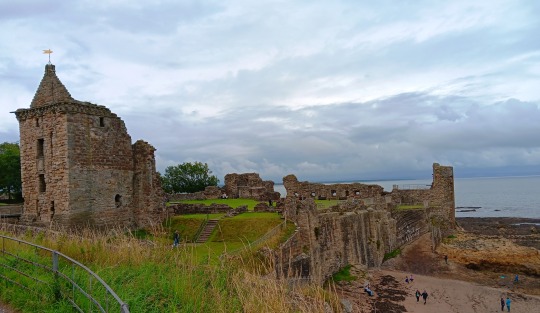
The bishops, not the kings, built St Andrews Castle in the 1100s. Two centuries later, Church support was crucial in the resistance against England.
The castle we see today (pictured above) is what's left of a fortress built by a bishop in the 1390s to make sure it would never fall into English hands again.
And it was clerics who founded the University. Some of its buildings date from the 16th century.
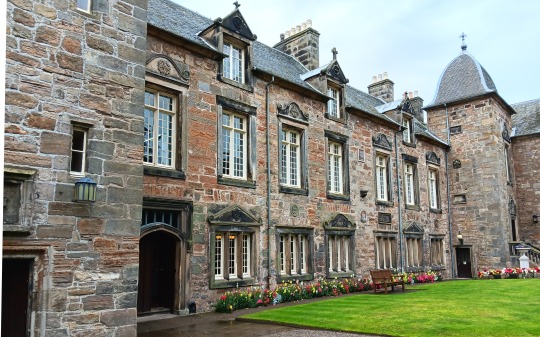
The Reformation, however, had particularly far-reaching consequences in Scotland. The Church was not transformed: it was obliterated, resulting in the permanent downgrading of St Andrews.
The archbishops started by hunting down Lutherans in the 1520s. In 1528 one preacher was burnt at the stake outside St Salvator's College (its 19th-century incarnation is below right, with a nearby grand hall on the left).

It didn't help when the English king, after breaking with Rome, attacked Scotland for refusing to follow suit. The Scottish Church was able to play the nationalist card and call Protestants traitors.
Things got worse after the Scottish king died in 1542. His daughter Mary was a baby, so a regency was organised. Although the regent himself was moderate Catholic, the king's French widow, Marie de Guise, fanned the flames of Popish extremism.
South of the border, Henry VIII renewed his attacks – this time aimed at forcing a marriage between his own son and Mary. This only strengthened Catholic diehards in Scotland.
In 1546 another Protestant was burnt alive in front of St Andrews Castle. Some of his followers made their way inside, stabbed the archbishop, hung his body from the castle walls and dug in. Then ensuing siege began lasted a year.
In 1547, Protestant ministers were allowed to join the hold-outs. One of them, John Knox, used that opportunity to form Scotland's first Protestant congregation.
But Marie de Guise, who was in no mood for negotiation, got French gunboats to bomb the castle. The rebels surrendered. Knox and others were bundled onto French galleys. They may owe their lives to the fact that the new archbishop, the regent's own brother, favoured appeasement.
The most dangerous time for a bad regime, Tocqueville wrote, is when it tries to reform itself. He was talking about France's absolute monarchy, but the rule also explains the end of Apartheid and the fall of Communism.
And it is confirmed by the fate of the Scottish Church. By the mid-1550s, it was no longer in lockstep with the Royal Palace. While the archbishop in St Andrews had given up clobbering Protestants, across the Firth Marie de Guise was keen on persecution. Power was divided.
Meanwhile, Knox was biding his time. After his release from the galley he knocked around Reformation Europe, reading up on predestination and honing his rhetorical skills. In 1559, sensing another opportunity, he returned home from Geneva.
Knox – now a full-blown Calvinist - was declared persona non grata by the government. But he managed to make his way to Perth where he had sympathisers. The local priest allowed Knox to speak during Mass. His sermon on idolatry incited the crowd to trash the church on the spot.
Knox went on to St Andrews, Antichrist's high command in Scotland. His imprecations against the "Hoore of Babylon" had the intended effect: the cathedral was ransacked. A year later Marie de Guise was dead and the Edinburgh Parliament rejected papal authority.
It meant the end of St Andrews as a religious centre. To see why, you have to understand the nature of the Scottish Reformation.
Elsewhere in Europe, the break with Rome was driven by local princes, who adapted existing institutions to the new faith. The new Church of England replaced the old English Church. The Canterbury cathedral had a new master but it remained a religious HQ.
Scotland's reformation, by contrast, was imposed on hostile rulers. Thus the Presbyterian Church of Scotland was nothing like the old Scottish Church. Knox rejected the hierarchical model. The Kirk was a grassroots organisation: no bishops, much less archbishops, and no alliance with the state.
This is why Canterbury's Cathedral still stands tall and St Andrews' has been left to crumble (top picture). The repository of relics is a relic itself.
Powerful people still come to St Andrews - but only to hit the links or put their kids through college, not to kiss any rings.

1 note
·
View note
Text
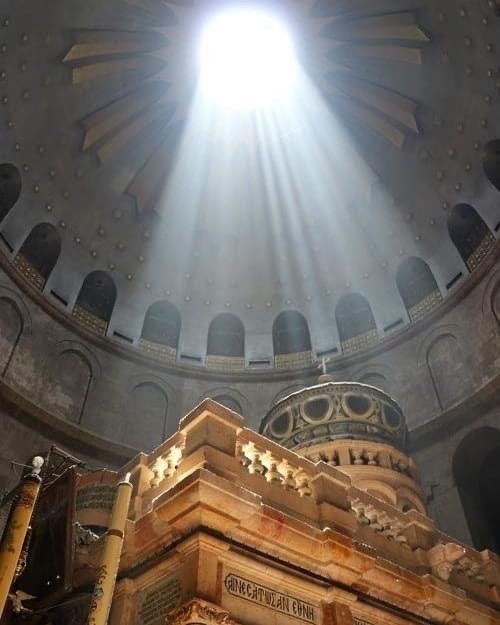
WHERE IS THE CHURCH ESTABLISHED BY JESUS CHRIST?
Our Lord Jesus Christ said: “...I will build my Church, and the gates of hell shall not prevail against it” (Matthew 16:18). If Christ said that the gates of hell shall not prevail against His Church; is it possible that His Church doesn’t exist anymore? Did it vanish or does it still exist? Since the Roman-Catholic church was established in the year 1054 and protestant churches after the 1517 reformation - where is the Church that was established by Christ 2000 years ago?
THE ORIGINAL CHURCH:
Presently there is a great number of sects that believe that they are the True Church of Christ regardless of the fact that they were all established recently by people and don’t have any connection with the original Church that was established by Christ 2000 years ego. The true Church was established by Our Lord Jesus Christ - all other sects are man-made institutions. Just to give a few examples: Lutheran, religion was founded by Martin Luther, an ex-monk of the Catholic church, in the year 1517. The church of England was founded by King Henry VIII in the year 1534 because the Pope would not grant him a divorce with the right to re-marry. Presbyterian religion was founded by John Knox in Scotland in the year 1560. Congregationalist, religion was originated by Robert Brown in Holland in 1582. Protestant Episcopalian religion was an offshoot of the church of England, founded by Samuel Senbury in the American colonies in the 17th century. Baptist, religion was established by John Smyth, who launched it in Amsterdam in 1606. Dutch Reformed church, was established by Michelis Jones in New York in 1628. Methodist religion was founded by John and Charles Wesley in England in 1774. Mormon (Latter Day Saints), was established by Joseph Smith who started this religion in Palmyra, New York, in 1829. Salvation Army sect began with William Booth in London in 1865. Christian Scientist started in the year 1879 and Mary Baker Eddy was its founder. Religious organizations known as "church of the Nazarene, Pentecostal Gospel," "Holiness church," or "Jehovah's Witnesses," is one of the thousands of new sects founded by men within the past hundred years.
Rome was part of the Orthodox Church for the first thousand years of its history, however, in 1054, the Pope of Rome broke away from the other four Apostolic Patriarchates (Constantinople, Alexandria, Antioch and Jerusalem), by tampering with the Original Creed of the Church, and considering himself to be infallible. That’s how Roman-Catholicism was originated by the pope.
Orthodox Church was founded in the year 33 by our Lord Jesus Christ, the Son of God. The faith has not changed since that time. Orthodox Church is now almost 2,000 years old. The Holy Orthodox Church, Church of the Apostles and the Fathers is the true: "One, Holy, Universal and Apostolic Church."
If by the Grace of the Holy Spirit you have been in search for the original Church established by Jesus Christ – we invite you to study History of the Christianity, Holy Scriptures and Holy Fathers from earliest ages till now.
WHAT IS THE ORTHODOX CHURCH?
On the one hand, it is the oldest Church in Christendom. On the other hand, it’s new to most people in North America. In the twentieth century alone, an estimated 40 million Orthodox Christians gave their lives for their faith. So high is the commitment of Orthodox Christians to Christ and His Church, she has often been called “the Church of the Martyrs.” She is the Church of some of history’s greatest theologians, scholars, scientist and writers like: St. John Chrysostom, St. Justin Martyr, Blessed Augustine, Dostoyevsky, Nikola Tesla, Alexander Solzehenitsyn etc. But what exactly is this Orthodox Church? What are her roots? What are her beliefs? And why are there so many who have never heard of her?
A BRIEF HISTORY:
The Orthodox Church is the original Christian Church, the Church founded by the Lord Jesus Christ and described in the pages of the New Testament. Her history can be traced in unbroken continuity all the way back to Christ and His Twelve Apostles. Incredible as it seems, for over twenty centuries she has continued in her undiminished and unaltered faith and practice. Today her apostolic doctrine, worship, and structure remain intact. The Orthodox Church maintains that the Church is the living Body of Jesus Christ. Many of us are surprised to learn that for the first 1000 years of Christian history there was just one Church. It was in the eleventh century that a disastrous falling away of Latin West occurred. Although it had been brewing for years, the so-called “Great Schism” of 1054 represented a formal falling away of Rome from Orthodoxy. At the core of the controversy were two vitally important areas of disagreement: the role of the papacy, and the manner in which doctrine is to be interpreted. But what is the real difference? One writer has compared Orthodoxy to the faith of Rome and Protestantism in this basic fashion: Orthodoxy has maintained the New Testament tradition, whereas Rome has often added to it and Protestantism subtracted from it. For example, Rome added to the ancient Creed of the Church, while numerous Protestant churches rarely study or recite it. Rome has layers of ecclesiastical authority; much of Protestantism is anti-hierarchical or even “independent” in polity. Rome introduced indulgences and purgatory; in reaction, Protestantism shies away from good works and discipline. In these and other matters, the Orthodox Church has steadfastly maintained the Apostolic Faith. She has avoided both the excesses of papal rule and of congregational independence. She understands the clergy as servants of Christ and His people and not as a special privileged class. She preserved the Apostles’ doctrine of the return of Christ at the end of the age, of the last judgment and eternal life, and continues to encourage her people to grow in Christ through union with Him. In a word, Orthodox Christianity has maintained the Faith “once for all delivered to the saints.”
The Orthodox Church in North America:
People devoted to Christ, but distressed and frustrated by the directions being taken in both Roman Catholic and Protestant circles, and desiring a more full worship and spiritual life, are turning to the changeless, the original Church of Christ - The Holy Orthodox Church. It only makes sense that the Church from which the Bible came would be the Church where the faith described in the Bible could be lived out and preserved. The Church which brought Orthodoxy to North America is now bringing North America to Orthodoxy. Constantly, people are being introduced to the faith and worship of the Orthodox Church. New Churches are beginning in cities and towns from coast to coast. Not surprisingly, there is a great interest in Orthodoxy being expressed today by the non-orthodox population in America. People are discovering Orthodoxy as a place where the search for spiritual reality finds fulfillment.
May the Grace of the Holy Spirit guide you to our Lord Jesus Christ and His: One, Holy, Universal and Apostolic Church.
“Come and see” (John 1:46).
0 notes
Text

petpets
#impzart#oc art#original character#bright colors#artists on tumblr#anthro#furry#<- technically he's a human according to his universe's standards. which is funny to think about#<- also does he count as a furry?????? idk how to tag this#also also those are cason's hands :)#knox the apostle
19 notes
·
View notes
Note
You mentioned a post of Queer Heroes of the 2010's in your tags, would you share that?
I shared a quote from Derek Knox where he points out that it's only in the past 10 years that we had a sizable number of queer members of the church who would come out as queer and then stay. Maybe not stay forever, but many stayed a few years and that caused a change in dynamics because leaders had to deal with us, and be asked our questions, and many members for the first time finally knew someone who is LGBTQIA+
It reminded me of a post, the one I mentioned in the tags, Queer Heroes of the 2010's. If you read through it, you can see as the years go by, more and more queer Mormons are stepping up and speaking out.
We're clearly having an impact. Last August's remarks by Elder Holland at BYU were the first time I can remember one of the apostles attacking celibate gay members who are living as the church asks them to. His remarks suggest he would prefer we stay but remain quiet, not wear rainbows, not come out.
By being present and wanting to be treated with dignity and respect, to be treated the same as everyone else, we're making people think about how Jesus would treat us and if what's being asked of us is fair. Those are all fair things to want and to ask.
15 notes
·
View notes
Text
Our Morning Offering – 6 July – The Octave Day of Saints Peter and Paul, Apostles – What Fairer Light?
Our Morning Offering – 6 July – The Octave Day of Saints Peter and Paul, Apostles Decora Luce AeternitatisWhat Fairer Light?Attrib. to H Elphis (Died 493) Wife of BL Severinus Boethius c 477– 524)Trans. Msgr Ronald Knox (1888–1957) What fairer light is thisthan time itself doth own,The golden day with beamsmore radiant brightening?The Princes of God’s Churchthis Feast day doth enthrone,To…
#bl severinus boethius#catholic#decora luce aeternitatis#h elphis#msgr ronald knox#roman catholic#sts peter and paul#what fairer light?
1 note
·
View note
Note
Top five favorite beverages? Top five favorite works of art? Top five favorite saints/historical Christian figures? :)
oooh good ones!! :)
top 5 beverages:
5. i don't drink alcohol very much but i am unfortunately a big whiskey fan....
4. root beer
3. chai
2. orange juice (or any kind of orange + mango combination... heavenly)
1. herbal tea
i'm going to have to think long and hard about my top 5 works of art, i've been sitting on this for 2 days and i've not been able to sort them out! I'll reblog this post when i do though!
top 5 historical Christian figures/saints (i'm excluding the original apostles because that would make it too hard):
5. john calvin
4. pelagius
3. john knox
2. geoffrey of monmouth (the historia regum brittaniae is one of my favorite medieval books)
1. joan of arc, always #1 in my heart
2 notes
·
View notes
Text

Msgr Ronald Knox (1888-1957) has written of the paradoxes of St Philip’s Neri’s vocation—the vocation which he bequeathed to his sons:
… an apostle of the heathen, who finds his heathen not in the remote Indies, but in the very heart and hearth of Christendom; the hermit, who looks for solitude in that most desolate of all wildernesses, a great city; the reformer of the Church who radiates influence from a cell, instead of passing resolutions in the council chamber of Trent.
5 notes
·
View notes
Photo

The tree in the centre has the legend "The church catholick". Banderolles around the trunk from the ground upwards read "Jesus Christ"; "Bishop of our soules 1 Pet. 2.25"; "12 apostles bishops Act 1.20"; and "Their successors bishops Acts 20.28". Lettering up the trunk of the tree, from "The church catholick": "Governed by episcopacy 1541 yeares". The tree being planted on the left has the legend "New, but not true, plants." while the one on the right has "These hold neither root not order". Two subsidiary trunks break off from the base of the main trunk. The left one is lettered "Presbytery. Began 1541" and has branches engraved with the names of reformers: Smectymnuus (pseudonym of a group of Puritans), [Christopher] Cartwright, [John] Knox, [Theodore] Beza, [Jean] Calvin. The right one is lettered "Independency began 1647" and has branches engraved with the names of [Sydrach] Simpson, Burrow [Jeremiah Burroughs], [William] Bridge, [Philip] Nye and [Thomas] Goodwin, all members of the Independent church in the 1640s. A banderolle linking the two split-off trunks says "These hold the roote, but not the order of the Catholick church"
The branches arising from the trunk are engraved with the names of places where churches were formed: Abyssenes; Cyrene; Numidia; Islands; Egypt; France; Syria; Italie; Greece; Asia Minor; Spaine; Britania; India. Higher branches are engraved with the names of the apostles. The fruits of the tree are crowned, and engraved with the names of churches which appointed bishops. The outermost leaves of the tree are engraved with the names of church fathers and early saints
A great cedar tree representing the Catholic church, contrasted with two smaller trees representing later denominations. Engraving after W. Cave, ca. 1675. Wellcome Collection. Attribution 4.0 International (CC BY 4.0)
3 notes
·
View notes
Text
Events 2.14
748 – Abbasid Revolution: The Hashimi rebels under Abu Muslim Khorasani take Merv, capital of the Umayyad province Khorasan, marking the consolidation of the Abbasid revolt. 842 – Charles the Bald and Louis the German swear the Oaths of Strasbourg in the French and German languages. 1014 – Pope Benedict VIII crowns Henry of Bavaria, King of Germany and of Italy, as Holy Roman Emperor. 1130 – The troubled 1130 papal election exposes a rift within the College of Cardinals. 1349 – Several hundred Jews are burned to death by mobs while the remaining Jews are forcibly removed from Strasbourg. 1530 – Spanish conquistadores, led by Nuño de Guzmán, overthrow and execute Tangaxuan II, the last independent monarch of the Tarascan state in present-day central Mexico. 1556 – Having been declared a heretic and laicized by Pope Paul IV on 4 December 1555, Archbishop of Canterbury Thomas Cranmer is publicly defrocked at Christ Church Cathedral. 1556 – Coronation of Akbar as ruler of the Mughal Empire. 1613 – Wedding of Princess Elizabeth and Frederick V of the Palatinate at Whitehall Palace, London. 1655 – The Mapuches launch coordinated attacks against the Spanish in Chile beginning the Mapuche uprising of 1655. 1778 – The United States flag is formally recognized by a foreign naval vessel for the first time, when French Admiral Toussaint-Guillaume Picquet de la Motte renders a nine gun salute to USS Ranger, commanded by John Paul Jones. 1779 – American Revolutionary War: The Battle of Kettle Creek is fought in Georgia. 1779 – James Cook is killed by Native Hawaiians near Kealakekua on the Island of Hawaii. 1797 – French Revolutionary Wars: Battle of Cape St. Vincent: John Jervis, (later 1st Earl of St Vincent) and Horatio Nelson (later 1st Viscount Nelson) lead the British Royal Navy to victory over a Spanish fleet in action near Gibraltar. 1804 – Karađorđe leads the First Serbian Uprising against the Ottoman Empire. 1831 – Ras Marye of Yejju marches into Tigray and defeats and kills Dejazmach Sabagadis in the Battle of Debre Abbay. 1835 – The original Quorum of the Twelve Apostles, in the Latter Day Saint movement, is formed in Kirtland, Ohio. 1849 – In New York City, James Knox Polk becomes the first serving President of the United States to have his photograph taken. 1852 – Great Ormond St Hospital for Sick Children, the first hospital in England to provide in-patient beds specifically for children, is founded in London. 1855 – Texas is linked by telegraph to the rest of the United States, with the completion of a connection between New Orleans and Marshall, Texas. 1859 – Oregon is admitted as the 33rd U.S. state. 1876 – Alexander Graham Bell applies for a patent for the telephone, as does Elisha Gray. 1879 – The War of the Pacific breaks out when the Chilean Army occupies the Bolivian port city of Antofagasta. 1899 – Voting machines are approved by the U.S. Congress for use in federal elections. 1900 – The British Army begins the Battle of the Tugela Heights in an effort to lift the Siege of Ladysmith. 1903 – The United States Department of Commerce and Labor is established (later split into the Department of Commerce and the Department of Labor). 1912 – Arizona is admitted as the 48th and the last contiguous U.S. state. 1912 – The U.S. Navy commissions its first class of diesel-powered submarines. 1918 – Russia adopts the Gregorian calendar. 1919 – The Polish–Soviet War begins. 1920 – The League of Women Voters is founded in Chicago. 1924 – The Computing-Tabulating-Recording Company changes its name to International Business Machines Corporation (IBM). 1929 – Saint Valentine's Day Massacre: Seven people, six of them gangster rivals of Al Capone's gang, are murdered in Chicago. 1942 – World War II: Battle of Pasir Panjang contributes to the fall of Singapore. 1943 – World War II: Rostov-on-Don, Russia is liberated. 1943 – World War II: Tunisia Campaign: General Hans-Jürgen von Arnim's Fifth Panzer Army launches a counter-attack against Allied positions in Tunisia. 1944 – World War II: In the action of 14 February 1944, a Royal Navy submarine sinks a German-controlled Italian Regia Marina submarine in the Strait of Malacca. 1945 – World War II: On the first day of the bombing of Dresden, the British Royal Air Force and the United States Army Air Forces begin fire-bombing Dresden. 1945 – World War II: Navigational error leads to the mistaken bombing of Prague, Czechoslovakia by a United States Army Air Forces squadron of B-17s assisting in the Soviet Red Army's Vistula–Oder Offensive. 1945 – World War II: Mostar is liberated by Yugoslav partisans 1945 – President Franklin D. Roosevelt meets King Ibn Saud of Saudi Arabia aboard the USS Quincy, officially beginning U.S.-Saudi diplomatic relations. 1946 – The Bank of England is nationalized. 1949 – The Knesset (parliament of Israel) convenes for the first time. 1949 – The Asbestos Strike begins in Canada. The strike marks the beginning of the Quiet Revolution in Quebec. 1961 – Discovery of the chemical elements: Element 103, Lawrencium, is first synthesized at the University of California. 1966 – Australian currency is decimalized. 1979 – In Kabul, Setami Milli militants kidnap the American ambassador to Afghanistan, Adolph Dubs who is later killed during a gunfight between his kidnappers and police. 1983 – United American Bank of Knoxville, Tennessee collapses. Its president, Jake Butcher, is later convicted of fraud. 1989 – Union Carbide agrees to pay $470 million to the Indian government for damages it caused in the 1984 Bhopal disaster. 1989 – Iranian leader Ruhollah Khomeini issues a fatwa encouraging Muslims to kill Salman Rushdie, author of The Satanic Verses. 1990 – Ninety-two people are killed when Indian Airlines Flight 605 crashes in Bangalore, India. 1990 – The Voyager 1 spacecraft takes the photograph of planet Earth that later becomes famous as Pale Blue Dot. 1998 – An oil tanker train collides with a freight train in Yaoundé, Cameroon, spilling fuel oil. One person scavenging the oil created a massive explosion which killed 120. 2000 – The spacecraft NEAR Shoemaker enters orbit around asteroid 433 Eros, the first spacecraft to orbit an asteroid. 2003 – Iraq disarmament crisis: UNMOVIC Executive Chairman Hans Blix reports to the United Nations Security Council that disarmament inspectors have found no weapons of mass destruction in Ba'athist Iraq. 2004 – In a suburb of Moscow, Russia, the roof of the Transvaal water park collapses, killing more than 28 people, and wounding 193 others. 2005 – In Beirut, 23 people, including former Prime Minister Rafic Hariri, are killed when the equivalent of around 1,000 kg of TNT is detonated while Hariri's motorcade drives through the city. 2005 – Seven people are killed and 151 wounded in a series of bombings by suspected al-Qaeda-linked militants that hit Makati, Davao City, and General Santos City, all in the Philippines. 2005 – YouTube is launched by a group of college students, eventually becoming the largest video sharing website in the world and a main source for viral videos. 2008 – Northern Illinois University shooting: A gunman opens fire in a lecture hall of Northern Illinois University in DeKalb County, Illinois, resulting in six fatalities (including the gunman) and 21 injuries. 2011 – As a part of Arab Spring, the Bahraini uprising begins with a 'Day of Rage'. 2018 – Jacob Zuma resigns as President of South Africa. 2018 – A shooting at Marjory Stoneman Douglas High School in Parkland, Florida is one of the deadliest school massacres with 17 fatalities and 17 injuries. 2019 – Pulwama attack takes place in Lethpora in Pulwama district, Jammu and Kashmir, India in which 40 Central Reserve Police Force personnel and a suicide bomber were killed and 35 were injured.
1 note
·
View note